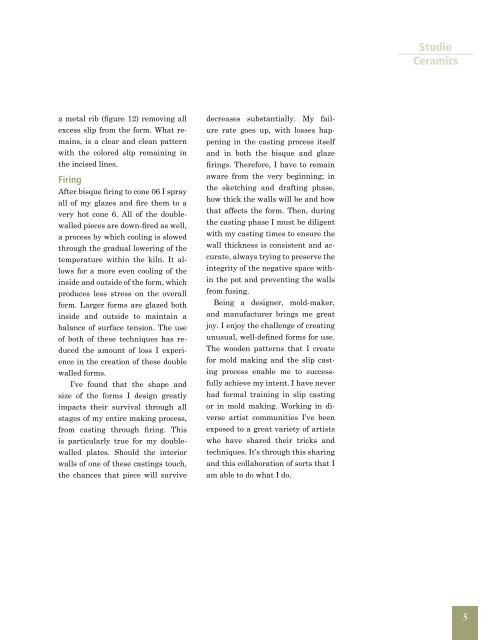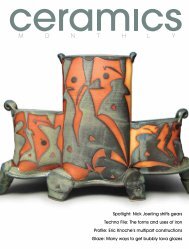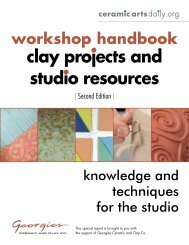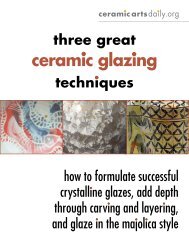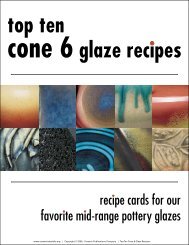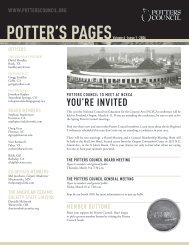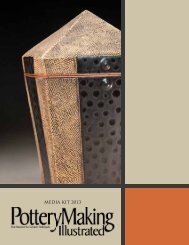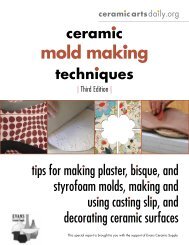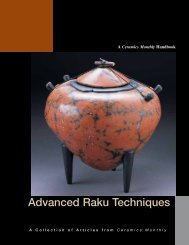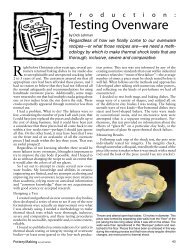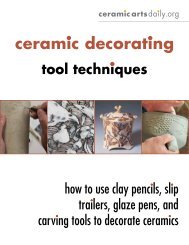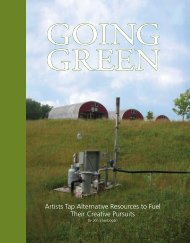You also want an ePaper? Increase the reach of your titles
YUMPU automatically turns print PDFs into web optimized ePapers that Google loves.
a metal rib (figure 12) removing all<br />
excess slip from the form. What remains,<br />
is a clear and clean pattern<br />
with the colored slip remaining in<br />
the incised lines.<br />
Firing<br />
After bisque firing to cone 06 I spray<br />
all of my glazes and fire them to a<br />
very hot cone 6. All of the doublewalled<br />
pieces are down-fired as well,<br />
a process by which cooling is slowed<br />
through the gradual lowering of the<br />
temperature within the kiln. It allows<br />
for a more even cooling of the<br />
inside and outside of the form, which<br />
produces less stress on the overall<br />
form. Larger forms are glazed both<br />
inside and outside to maintain a<br />
balance of surface tension. The use<br />
of both of these techniques has reduced<br />
the amount of loss I experience<br />
in the creation of these double<br />
walled forms.<br />
I’ve found that the shape and<br />
size of the forms I design greatly<br />
impacts their survival through all<br />
stages of my entire making process,<br />
from casting through firing. This<br />
is particularly true for my doublewalled<br />
plates. Should the interior<br />
walls of one of these castings touch,<br />
the chances that piece will survive<br />
decreases substantially. My failure<br />
rate goes up, with losses happening<br />
in the casting process itself<br />
and in both the bisque and glaze<br />
firings. Therefore, I have to remain<br />
aware from the very beginning; in<br />
the sketching and drafting phase,<br />
how thick the walls will be and how<br />
that affects the form. Then, during<br />
the casting phase I must be diligent<br />
with my casting times to ensure the<br />
wall thickness is consistent and accurate,<br />
always trying to preserve the<br />
integrity of the negative space within<br />
the pot and preventing the walls<br />
from fusing.<br />
Being a designer, mold-maker,<br />
and manufacturer brings me great<br />
joy. I enjoy the challenge of creating<br />
unusual, well-defined forms for use.<br />
The wooden patterns that I create<br />
for mold making and the slip casting<br />
process enable me to successfully<br />
achieve my intent. I have never<br />
had formal training in slip casting<br />
or in mold making. Working in diverse<br />
artist communities I’ve been<br />
exposed to a great variety of artists<br />
who have shared their tricks and<br />
techniques. It’s through this sharing<br />
and this collaboration of sorts that I<br />
am able to do what I do.<br />
<strong>Studio</strong><br />
<strong><strong>Ceramic</strong>s</strong><br />
5


